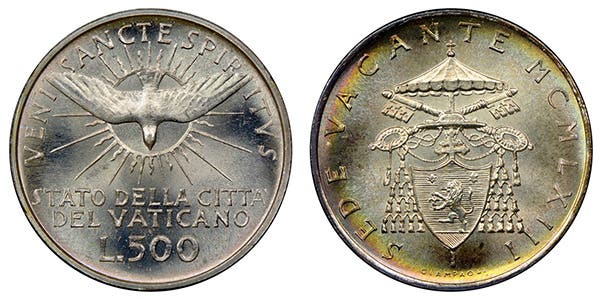Coins of Judaea in Goldberg auction
Judaean rarities will be featured in a Jan. 8-10, 2019, New York City sale conducted by Ira and Larry Goldberg Auctioneers. In the spotlight will be the Palm Desert Collection…
Judaean rarities will be featured in a Jan. 8-10, 2019, New York City sale conducted by Ira and Larry Goldberg Auctioneers.
In the spotlight will be the Palm Desert Collection and the collection of Sholomo Moussaieff consisting of over 150 extremely rare Judaean and Judaean-related Roman Coins.
Ira Goldberg indicates that this may be the first auction to ever feature two extremely rare Year 4 shekels.
There will also be a Year 5 shekel, the Shoshana specimen, which sold for nearly $90,000 in 2012.
Shekels form the heart of any ancient Judaean coin collection, and there is a remarkable group in the Palm Desert Collection. It includes one or more half shekels from Year 1, 2, and 3 of the First Revolt (66-70 C.E.).
Each of these is extremely fine or better.
The coins of the Second Revolt (132-135 C.E.) are also rich in rarities. Highlighting about a half dozen selas (tetradrachms) is a Year 1 with the Hebrew inscription “JERUSALEM” surrounding the Temple; a Year 2 with the under-coin of Emperor Galba clearly visible, including his profile and parts of the inscription; and a Year 3 with the enigmatic wavy line above the Temple. There is also a nice selection of bronzes and zuzim (denarii).
In addition to rare shekels, half shekels, selas, and zuzim of the First Revolt and Second Revolt, the Palm Desert Collection also will offer a number of extremely rare Judaean-related Roman coins. These coins are less often encountered at dealers and auctions because they are never found in quantity in hoards. Judaean coins were buried at the time of these wars for safekeeping, but there was never any reason for Romans to bury Judaean-related coins.
The earliest Judaean-related Roman coin is an extremely fine tetradrachm, with superb portraits of Cleopatra and her lover Mark Antony, that was issued in Akko.
The most comprehensive and well-known Judaean-related Roman coin series is “Judaea Capta,” consisting of bronze, silver, and gold coins celebrating the Roman victory over Judaea in 70 C.E. The vast majority of these coins carry the inscription JUDAEA CAPTA, JUDAEA AUGUST, or JUDAEA; however, some of the rarer varieties do not – including some of the coins in the Goldberg sale: a Vespasian bronze sestertius with the hybrid inscription JUDAEA AUGUST; a Vespasian gold aureus inscribed DE JUDAEIS, minted at Lugdunum, c. 72 C.E.; and another aureus of Vespasian depicting two Jewish captives before triumphant Roman soldiers, horses, etc., with TRIUMP AUG in exergue.
The singularly important Judaean-related Roman coin issued in between the two Jewish revolts against Rome features the Emperor Nerva (96-98 C.E.) and a palm tree surrounded by the inscription FISCI JUDAICI CALUMNIA SUBLATA (the abuses of the Jewish Tax are ended) and SC (Senatus Consulto = by consent of the Senate).
The event that might have ignited the Second Revolt, the visit of Hadrian to Jerusalem in 131 C.E., was where he stated his plans to convert the Jewish Temple into a Roman one. This is commemorated on two very rare bronze coins in the Goldberg auction. On the first coin, a sestertius, Hadrian is greeted by a female (representing the Roman province of Judaea) who hands the Emperor a dove, and he in turn is offering her an olive branch of peace, with three small Jewish figures in the background, surrounded by the inscription ADVENTU AUG JUDAEA and S.C. in exergue.
The second coin, an “as” denomination, commemorates the same event but is even rarer as a type and denomination; it features Hadrian with an arm outstretched to a kneeling female representation of Judaea and three small Jews (one carrying an olive branch) in the background; the inscription is JUDAEA in exergue.
Biblical coins ranging from small bronze leptons issued by Roman Prefects and Procurators of Judaea are estimated at under $100 each, making this auction accessible to all collectors.
As such, the catalog and prices realized will serve as a guidebook to the popular field of Biblical Numismatics for many years.
The New York Sale catalog can be obtained by telephoning (310) 551-2646; it is regularly priced at $25, but mention that you read about it in Numismatic News and the price is $15 in the United States or $20 overseas.
The catalog will soon be on view at www.goldbergcoins.com.
This article was originally printed in Numismatic News Express. >> Subscribe today
If you like what you've read here, we invite you to visit our online bookstore to learn more about Standard Catalog of World Coins, 1701-1800.








